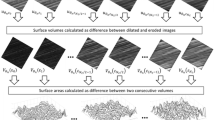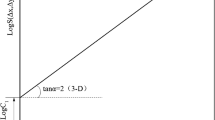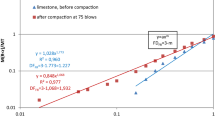Abstract
The aim of this study is to determine and compare surface parameters at the meso level of concrete fractured surfaces using two different laser scanning systems. One of the laser scanning systems is the cost-efficient system DAVID 3D; the other one is the high-end system LEICA T-Scan. By means of these two systems the following surface parameters were determined: the minimum distance between two points, the number of points, the roughness and the fractal dimension. A calculation routine in Matlab© was developed to estimate numerically the fractal dimension with a modified method. A major finding of this study is the suitability of the DAVID 3D system for scanning fractured concrete surfaces at the meso-level (1–100 mm). If a higher resolution is needed the LEICA system is preferable due to its ability to measure a higher number of points within a given area.











Similar content being viewed by others
References
Wittmann FH (ed) (1983) Fracture mechanics of concrete. Elsevier, Amsterdam
Carpinteri A (1999) Three-dimensional fractal analysis of concrete fracture at the meso-level. Theor Appl Fract Mech 31:163–172
Issa M (2003) Fractal dimension—a measure of fracture roughness and toughness of concrete. Eng Fract Mech 70:125–137
Lange DA, Jennings HM, Shah SP (1993) Relationship between fracture surface roughness and fracture behavior of cement paste and mortar. J Am Ceram Soc 76:589–597
Mechtcherine V (2009) Fracture mechanical behavior of concrete and the condition of its fracture surface. Cem Concr Res 39:620–628
Wu K (2000) Reconstruction and analysis of 3-D profile of fracture surface of concrete. Cem Concr Res 30:981–987
Mandelbrot BB (1987) Die fraktale Geometrie der Natur. Akademie-Verlag, Berlin
Luhmann T, Robson S, Kyle S, Harley I (2007) Close range photogrammetry: principles, techniques and applications. Wiley, New York
Kraus K, Harley I (2007) Photogrammetry. Geometry from images and laser scans. de Gruyter, Berlin
Vosselman G, Maas H-G (2010) Airborne and terrestrial laser scanning. Whittles Publishing u.a., Dunbeath
Yan A, Wu K-R, Zhang D, Yao W (2001) Effect of fracture path on the fracture energy of high-strength concrete. Cem Concr Res 31:1601–1606
RILEM (1985) Determination of the fracture energy of mortar and concrete by means of three-point bend tests on notched beams. Mater Struct 18:287–290
DAVID Vision Systems GmbH. www.DAVID-laserscanner.com. Accessed 1 June 2011
Leica T-Scan—Leica T-Scan TS50-A Hochgeschwindigkeits-Scanner. Leica Geosystems, Deutschland. http://www.leica-geosystems.de/de/Leica-T-Scan_1836.htm. Accessed 1 June 2011
Deutsches Institut für Normung (2009) Prüfung von Festbeton. Beuth, Berlin
Winkelbach S, Molkenstruck S, Wahl F (2006) Low-cost laser range scanner and fast surface registration approach. In: Franke K, Müller K-R, Nickolay B, Schäfer R (eds) Pattern recognition. 28th DAGM symposium, Berlin, Germany, September 12–14, 2006, proceedings. Springer, Berlin
Drixler E (1993) Analyse der Form und Lage von Objekten im Raum. Beck, München
Piegl L, Tiller W (1997) The NURBS book. With 334 figures in 578 parts. Springer, Berlin
Author information
Authors and Affiliations
Corresponding author
Rights and permissions
About this article
Cite this article
Werner, S., Neumann, I., Thienel, KC. et al. A fractal-based approach for the determination of concrete surfaces using laser scanning techniques: a comparison of two different measuring systems. Mater Struct 46, 245–254 (2013). https://doi.org/10.1617/s11527-012-9898-y
Received:
Accepted:
Published:
Issue Date:
DOI: https://doi.org/10.1617/s11527-012-9898-y




